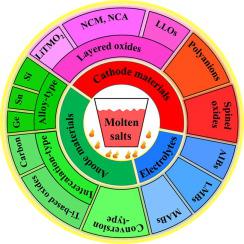Materials Today ( IF 21.1 ) Pub Date : 2022-10-07 , DOI: 10.1016/j.mattod.2022.09.005 Huan Liu , Xu Zhang , Shiman He , Di He , Yang Shang , Haijun Yu

|
The growing demand of advanced electrochemical energy storage devices for various applications, including portable electronic products, electric vehicles, and large-scale energy storage grids, has triggered extensive research interests and efforts on various rechargeable batteries such as lithium/sodium-ion batteries (LIBs/NIBs), aluminium-ion batteries (AIBs), liquid metal batteries (LMBs), and molten-air batteries (MABs) in the past decades. A key issue to push forward the development of these batteries is the exploration of high-performance electrodes and electrolytes, which calls for efficient and versatile synthetic methods. Molten salts (MSs), liquid-phase ionic compounds or mixtures, provide an effective platform to widen the reaction temperatures and enrich the chemical environments for the synthesis of novel electrode materials and electrolytes. In this review, the general principles of molten salts and recent research progresses on molten salt-based battery materials are surveyed. Molten-salt synthesis of electrode materials, including sintering and electrolysis, are emerging as competitive substitutes for conventional synthesis techniques. These methods have shown their effectiveness and uniqueness in adjusting the crystal structure, morphology, and performance of electrode materials for LIBs/NIBs, as suggested by recent progresses and applications of diverse cathodes (layered oxides, spinel oxides, polyanions, etc.) and anodes (metal oxides, alloys, carbons, etc.). Furthermore, the applications of molten salts as effective electrolytes are demonstrated in representative new-type secondary batteries including AIBs, LMBs and MABs. Finally, the emerging opportunities, challenges, and interesting research trends are envisioned to promote the further development of molten-salt methodology for rechargeable batteries.
中文翻译:

充电电池用熔盐
便携式电子产品、电动汽车和大型储能电网等各种应用对先进电化学储能设备的需求不断增长,引发了对锂/钠离子电池(LIBs)等各种可充电电池的广泛研究兴趣和努力/NIBs)、铝离子电池(AIBs)、液态金属电池(LMBs)和熔融空气电池(MABs)。推动这些电池发展的一个关键问题是探索高性能电极和电解质,这需要高效和通用的合成方法。熔盐 (MS)、液相离子化合物或混合物,为新型电极材料和电解质的合成提供了一个有效的平台来拓宽反应温度和丰富化学环境。本文综述了熔盐的一般原理和熔盐基电池材料的最新研究进展。电极材料的熔盐合成,包括烧结和电解,正在成为传统合成技术的竞争性替代品。这些方法在调整 LIBs/NIBs 电极材料的晶体结构、形态和性能方面显示出有效性和独特性,正如最近在不同阴极(层状氧化物、尖晶石氧化物、聚阴离子等)和阳极的进展和应用所表明的那样(金属氧化物、合金、碳等)。此外,熔盐作为有效电解质的应用在AIBs、LMBs和MABs等具有代表性的新型二次电池中得到了证明。最后,设想了新出现的机遇、挑战和有趣的研究趋势,以促进可充电电池熔盐方法的进一步发展。


















































 京公网安备 11010802027423号
京公网安备 11010802027423号